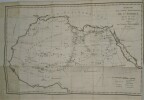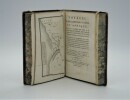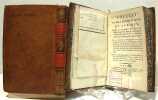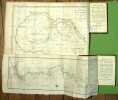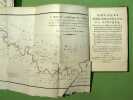12 books for « john lucas »Edit
-
Century
19th (1)
20th (5)
21st (3)
-
Countries
Belgium (1)
France (11)
-
Syndicate
ILAB (6)
SLAM (6)
Topics
Voyages en Afrique, entrepris et publiés par ordre de la Société anglaise d'Afrique ; avec le plan de fondation de cette société, et une carte du nord de l'Afrique, par le major Rennel : suivis d'extraits de voyages faits à la rivière de Gambie… et d'un mémoire écrit sous le règne de Charles II, concernant la grande quantité d'or qu'on trouve près de cette rivière ; avec une carte de ce fleuve et de ses environs, tracée sur les lieux.
Paris, Xrouet, Déterville, an XII (1804). 2 parties en un vol. in-8, XXIV-548 p. en numérotation continue, 2 cartes dépliantes hors-texte, demi-veau fauve moucheté de l'époque, dos lisse orné alternativement de grands fleurons et de semis géométriques dorés, pièce de titre cerise, encadrement d'un filet à froid sur les plats, filet doré sur les coupes, tranches marbrées.
Première traduction française. En 1788, fut créée à Londres la Société d'Afrique qui décida aussitôt de monter une expédition pour tenter la traversée d'est en ouest du continent, encore presque totalement inconnu en-dehors des zones côtières. John Ledyard (qui avait participé au troisième voyage de Cook et traversé l'Europe jusqu'à Irkoutsk avant d'être expulsé de Russie) fut chargé de la partie est du voyage. Il se rendit au Caire, fit de nombreuses observations sur les habitant mais succomba à la fièvre avant d'avoir pu commencer son voyage. Simon Lucas (qui fut vice-consul au Maroc et interprète de langues orientales près du gouvernement britannique) fut chargé de la partie ouest. Il se rendit à Tripoli pour rejoindre le Fezzan mais ne put dépasser la ville de Mesurate (Misratah). Le second volume est constitué d'Extraits de voyages faits à la rivière de Gambie, de Francis Moore qui vécut sur le fleuve de 1730 à 1735, pour le compte de la Royal African Company. On trouve également un Mémoire écrit sous le règne de Charles II, concernant la grande quantité d'or que l'on trouvait près de cette rivière.(Gay, 29 )
The Genius of Valhalla : The Life of Reginald Goodall
Paperback, 264 pages, released October 15, 2009 by The Boydell Press, very good general condition.
Voyages de MM. Lédyard et Lucas en Afrique,. Entrepris et publiés par ordre de la Société Anglaise d'Afrique... Suivis d'extraits de Voyages faits à la rivière de Gambie... et d'un Mémoire... concernant la grande quantité d'Or qu'on trouve près de cette rivière... Traduits de l'Anglais par A. J. N. Lallemant...
Paris, Xhrouet, Déterville, An XII, (1804). 2 volumes in-8, XXIVpp.-312pp.- 3ff.n.ch.- pp. 317 à 548- 2 grandes cartes repliées. Reliures de l'époque basane fauve racinée, dos lisses ornés de frises, vasques et fers dorés, pièces de titre cerise, tranches marbrées.
Première édition française, traduite par Antoine-Jean-Noël Lallemand. En 1788, la toute nouvelle Société Africaine de Londres commandita la traversée du continent d'Est en Ouest. L'aventurier John Ledyard (qui avait été du dernier voyage de Cook) fut chargé de la partie Est. Il se rendit au Caire et y mourut avant d'avoir pu se mettre en route, mais en laissant d'intéressantes notes sur l'Égypte et ses habitants. Simon Lucas, chargé de la partie Ouest, se rendit à Tripoli pour rejoindre le Fezzan mais il ne put dépasser la ville de Mesurate (Misratah). L’ouvrage est divisé en deux parties, la première contenant les récits de Ledyard et de Lucas, la seconde comprenant un Extrait du voyage de François Moore dans l’intérieur de l’Afrique, en remontant la rivière de Gambie... (la première édition avait paru en 1738), suivi d’un Mémoire sur la grande quantité d’or contenue dans le sable de la Gambie. Deux grandes cartes dépliantes : Esquisse de la Partie Septentrionale de l’Afrique tracée en 1790 par J. Rennell (51 x 33 cm au filet) & Carte de la Rivière de Gambie..., tracée sur les lieux par M. Jean Leach (65 x 21 cm au filet). - (Chadenat, 6039). - Cachet humide Eugène Gedel (début XX°s.) sur les titres, ex-libris manuscrit, à l'encre : Edgar Boutry, avocat à Moulins. Coins légèrement choqués, coiffes du tome I arasées, rousseurs claires tout au long des volumes et sur les cartes.
Rome 1450. Capgrave's Jubilee Guide. The Solace of Pilgrimes
, Brepols, 2022 Paperback, xcv + 442 pages, Size:156 x 234 mm, Illustrations:63 b/w, 1 col., Language(s):English, Middle English. ISBN 9782503594675.
Summary The scene is Rome in the fifteenth century, Golden Rome, a magnet drawing pilgrims by its architectural attractions and the magnitude of its religious importance as the mother of faith. The Austin friar John Capgrave attended Rome for the Jubilee in 1450, including the Lenten stations, and his Solace of Pilgrimes, intended as a guide for subsequent pilgrims, was written up following the author's own pilgrimage. In three parts it covers the ancient monuments, the seven principal churches and the Lenten stations, and other churches of note, especially those dedicated to the Blessed Virgin Mary. The work has been described as the most ambitious description of Rome in Middle English. The present edition offers a new Text based on a transcription of the author's holograph manuscript. Parallel with the Text there is a modern English Translation. The illustrations, mostly from a period slightly later than the 1450 Jubilee, aim to give some visual clue as to what Capgrave saw. There is a full account of the multiple sources that he used, most of which is the product of new research. Following the Text there is a Commentary that aims to provide some background information about the buildings and monuments that Capgrave focuses on, and to explain and illuminate any difficulties or points of interest in the Text. Capgrave is an omni-present guide leading us towards what he considered an appropriate interpretation of the classical past as a foundation for the Christian present, which built on it and surpassed it. TABLE OF CONTENTS Preface Abbreviations Introduction Select Bibliography Editorial Procedure The Solace of Pilgrimes by John Capgrave OSA Part I Ancient Rome Introduction and list of chapters in Part I ch 1 The original founders of Rome ch 2 The gates, walls and towers of Rome ch 3 The bridges of Rome ch 4 The hills of Rome ch 5 The 'palaces' in Rome ch 6 The triumphal arches in Rome ch 7 The cymyteries 'catacombs' in Rome ch 8 Holy places and their pre-Christian names ch 9 The Angulla Sancti Petri 'St Peter's Obelisk' ch 10 Pagan temples turned to Christian use ch 11 The Capitol ch 12 The statue of the Dioscuri ch 13 The statue of Marcus Aurelius at the Lateran ch 14 The Coliseum ch 15 The Pantheon ch 16 Ara Celi ch 17 The Mausoleum of Augustus ch 18 The Septizodium ch 19 The Circus of Tarquinius Priscus ch 20 The Cantharus in the atrium in front of old San Pietro ch 21 The 'pyramid' or tomb of Romulus ch 22 The paleys 'temple' of Trajan ch 23 The conch-shaped font where Constantine was allegedly baptized ch 24 The place called Omnis Terra (= Monte Testaccio) ch 25 The rulers of Rome from the time of Romulus to the last king Tarquinius ch 26 The rulers of Rome from Tarquinius to the first emperor ch 27 The emperors of Rome from Julius Caesar to Frederick II (d 1250) Part II The seven principal churches and the stations for Lent Prologus ch 1 San Pietro ch 2 San Paolo fuori le Mura ch 3 San Sebastiano ch 4 San Giovanni in Laterano ch 5 Santa Croce in Gerusalemme ch 6 San Lorenzo fuori le Mura ch 7 Santa Maria Maggiore ch 8 The station at Santa Sabina ch 9 The station at San Giorgio in Velabro ch 10 The station at Santi Giovanni e Paolo ch 11 The station at San Trifone ch 12 The station at San Giovanni in Laterano ch 13 The station at San Pietro in Vincoli ch 14 The station at Santa Anastasia ch 15 The station at Santa Maria Maggiore ch 16 The station at San Lorenzo in Panisperna ch 17 The station at Santi Apostoli ch 18 The station at San Pietro ch 19 The station at Santa Maria in Domnica ch 20 The station at San Clemente ch 21 The station at Santa Balbina ch 22 The station at Santa Cecilia in Trast vere ch 23 The station at Santa Maria in Trast vere ch 24 The station at San Vitale ch 25 The station at Santi Marcellino e Pietro ch 26 The station at San Lorenzo fuori le Mura ch 27 The station at San Marco ch 28 The station at Santa Pudenziana ch 29 The station at San Sisto Vecchio ch 30 The station at Santi Cosma e Damiano ch 31 The station at San Lorenzo in Lucina ch 32 The station at Santa Susanna ch 33 The station at Santa Croce in Gerusalemme ch 34 The station at Santi Quattro Coronati ch 35 The station at San Lorenzo in Damaso ch 36 The station at San Paolo fuori le Mura ch 37 The station at San Martino ai Monti and the station at San Silvestro in Capite ch 38 The station at Sant'Eusebio ch 39 The station at San Nicola in Carcere ch 40 The station at San Pietro ch 41 The station at San Crisogono ch 42 The station at San Ciriaco in Thermis ch 43 The station at San Marcello al Corso ch 44 The station at Sant'Apollinare ch 45 The station at San Stefano Rotunda ch 46 The station at San Giovanni alla Porta Latina ch 47 The station at San Giovanni in Laterano ch 48 The station at Santa Prassede and the station at Santi Nereo e Achilleo ch 49 The station at Santa Prisca ch 50 The station at Santa Maria Maggiore ch 51 The station at San Giovanni in Laterano ch 52 The station at Santa Croce in Gerusalemme ch 53 The station at San Giovanni in Laterano ch 54 The station at Santa Maria Maggiore Part III Other churches of note, especially those dedicated to our Lady Prologus ch 1 Santa Maria Rotunda (= Pantheon) ch 2 Santa Maria in Aracoeli ch 3 Lacking ch 4 Santa Maria sopra Minerva ch 5 Santa Maria Annunziata ch 6 Santa Maria in Transpontina ch 7 Santa Maria in Palmis ch 8 Santa Maria del Populo ch 9 Santa Maria Antiqua ch 10 Santa Maria in Cosmedin ch 11 Santa Maria Imperatrice ch 12 Santa Maria della Consolazione ch 13 Santa Maria in Portico Further chapters lacking Commentary Appendix Index of Names and Places
HERTFORDSHIRE A PORTRAIT IN COLOUR
THE DOVECOTE PRESS. 1993. In-8. Relié. Très bon état, Couv. fraîche, Dos impeccable, Intérieur frais. 126 pages. Nombreuses photos en couleurs de John HODDER hors texte, une carte et un portrait en couleurs. Texte en anglais. Une déchirure sur le premier plat de la jaquette.. Avec Jaquette. . A l'italienne. Classification Dewey : 420-Langue anglaise. Anglo-saxon
Classification Dewey : 420-Langue anglaise. Anglo-saxon
Meier John-P Degorce Jean-Bernard Ehlinger Charles Lucas Noël
Reference : 100141763
(2004)
UN CERTAIN JUIF : JESUS - TOME 1 LES DONNEES DE L'HISTOIRE: Tome 1 Les sources les origines les dates
CERF 2004 in8. 2004. Broché.
proche du neuf
UN CERTAIN JUIF : JESUS - TOME 3 LES DONNEES DE L'HISTOIRE: Tome 3 Attachements affrontements ruptures
CERF 2005 343 pages 15 2x4x22 4cm. 2005. Broché. 343 pages.
proche du très bon état intérieur propre dos légèrement insolé une ride
THE SILKEN CANOPY, A HISTORY OF THE PARACHUTE
Airlife. 1997. In-8. Relié. Bon état, Couv. convenable, Dos satisfaisant, Intérieur frais. 173 pages. Planches de photos noir et blanc.. Avec Jaquette. . . Classification Dewey : 420-Langue anglaise. Anglo-saxon
Classification Dewey : 420-Langue anglaise. Anglo-saxon
ARNOLD BENNETT, A STUDY OF HIS FICTION
Methuen & Co. 1974. In-8. Broché. Bon état, Couv. convenable, Dos satisfaisant, Intérieur frais. 235 pages.. . . . Classification Dewey : 420-Langue anglaise. Anglo-saxon
Universtity Paperbacks, 556. Classification Dewey : 420-Langue anglaise. Anglo-saxon
THE OXFORD BOOK OF FRENCH VERSE - XIIIth CENTURY - XIXth CENTURY
OXFORD UNIVERSITY PRESS. 1907. In-12. Relié cuir dos-coins. Etat d'usage, Coins frottés, Dos satisfaisant, Intérieur frais. 492 pages - ex libris - dos à 5 nerfs - titre, caissons et fleurons dorés sur le dos - plats et contre-plats jaspés -tranche en tête dorée - une annotation sur la page de garde et la page de titre. . . . Classification Dewey : 420-Langue anglaise. Anglo-saxon
texte en anglais et français Classification Dewey : 420-Langue anglaise. Anglo-saxon
THE OUTWARD URGE
Ballantine Book. 1959. In-12. Broché. Bon état, Couv. convenable, Dos satisfaisant, Intérieur acceptable. 143 pages.. . . . Classification Dewey : 420-Langue anglaise. Anglo-saxon
Ballantine Book, 341 K. The story of man's leap into the seas of space. Classification Dewey : 420-Langue anglaise. Anglo-saxon
 Write to the booksellers
Write to the booksellers
